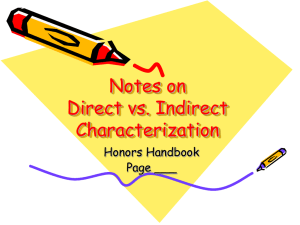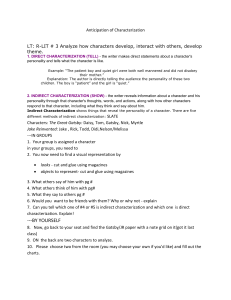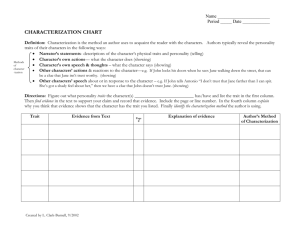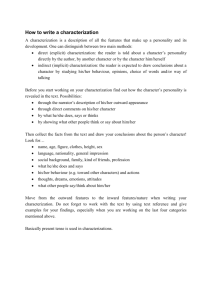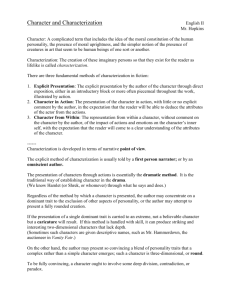Characterization within "A White Heron"
advertisement
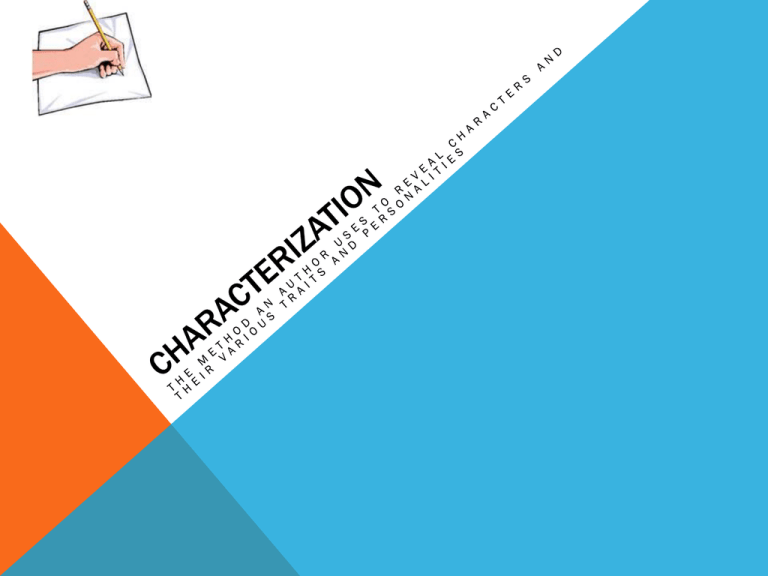
CHARACTER A person, animal or inanimate object portrayed in a literary work. Character Types a. Round – multiple traits b. Flat- 1 or 2 traits c. Dynamic –change w/i story d. Static – do not change Protagonist- main character Antagonist-character who opposes the protagonist CHARACTERIZATION The method an author uses to reveal characters and their various traits and personalities. As “good” readers, we need to try to understand everything we read. That means we should also understand the author’s purpose in writing the work. It’s easier to understand a story if you “know” the characters. CHARACTERIZATION CAN BE MANIFESTED IN FOUR WAYS: Thought Action Dialogue Narration Indirect Characterization Direct Characterization INDIRECT CHARACTERIZATION THROUGH THOUGHT The youth was in a little trance of astonishment. So they were at last going to fight. On the morrow, perhaps, there would be a battle, and he would be in it. For a time he was obliged to labor to make himself believe. He could not accept with assurance an omen that he was about to mingle in one of those great affairs of the earth. What is Henry thinking about? What personality traits are revealed to the reader in what Henry in thinking ? Stephen Crane The Red Badge of Courage INDIRECT CHARACTERIZATION THROUGH ACTION “I was about to speak when she sat up alertly and said Sh!” in a warning voice. A subdued impassioned murmur was audible in the room beyond, and Miss Baker leaned forward unashamed, trying to hear.” What do Miss Baker’s actions tell us about her? What trait regarding her personality is revealed? F. Scott Fitzgerald The Great Gatsby INDIRECT CHARACTERIZATION THROUGH DIALOGUE “…the butler left the porch and Daisy seized upon the momentary interruption and leaned toward me. “I’ll tell you a family secret,” she whispered enthusiastically. “It’s about the butler’s nose. Do you want to hear about the butler’s nose?’” What can we say about Daisy’s personality based on what she says? What trait is revealed? F. Scott Fitzgerald The Great Gatsby DIRECT CHARACTERIZATION THROUGH NARRATION In Maycomb County, it was easy to tell when someone bathed regularly, as opposed to yearly lavations: Mr. Ewell had a scalded look; as if an overnight soaking had deprived him of protective layers of dirt, his skin appeared to be sensitive to the elements. Mayella looked as if she tried to keep clean, and I was reminded of the row of red geraniums in the Ewell yard. What information about Mr. Elwell is the reader given? Of Mayella? WHY DOES THIS MATTER TO US? As “good” readers, we need to try to understand everything we read. That means we should also understand the author’s purpose in writing the work. It’s easier to understand a story if you “know” the characters. Dialogue How can I get everyone to like me? Liz Lemon Thought New York third-wave feminist, college educated, single and pretending to be happy about it, overscheduled… Exactly what it says Action Physically fit, food issues Low SelfEsteem, Seeks Acceptance and sleepeating Narration Paranoid, Envious New York third-wave feminist, college educated, single and pretending to be happy about it, overscheduled Low SelfEsteem, Seeks Acceptance Liz Lemon Paranoid, Envious Indirect Characterization Direct Characterization Physically fit, food issues Character Protagonist or Antagonist Round or Flat Evidence From Text (Is proof DIRECT OR INDIRECT CHARACTERIZATION…if indirect, is it through THOUGHT, ACTION, DIALOGUE) Characteristic of Personality or Physical Trait Dynamic or Static Why? SYLVIA MRS. TILLEY ORNITHOLOGIST Task: Complete the table, being sure to address ALL headings with accurate information. L.F.2.3.1 Explain, interpret, compare, describe, analyze, and/or evaluate character in a variety of fiction: Note: Character may also be called narrator or speaker. •• the actions, motives, dialogue, emotions/ feelings, traits, and relationships between characters within fictional text •• the relationship between characters and other components of a text •• the development of complex characters and their roles and functions within a text Character Protagonist or Antagonist SYLVIA Protagonist Round or Flat Round Evidence From Text (Is proof DIRECT OR INDIRECT CHARACTERIZATION…if indirect, is it through THOUGHT, ACTION, DIALOGUE) She was not often in the woods so late as this, and it made her feel as if she were a part of the gray shadows and the moving leaves. INDIRECTTHOUGHT She did not dare to look boldly at the tall young man, who carried a gun over his shoulder, but she came out of her bush and again followed the cow, while he walked alongside. INDIRECT- ACTION She had never seen anybody so charming and delightful; the woman's heart, asleep in the child, was vaguely thrilled by a dream of love. “…this lonely country child.” DIRECT Characteristic of Personality or Physical Trait Dynamic or Static Nature-loving (characteristic of personality) Dynamic Remembers how they watched the sea and the morning come in together and realizes nature’s safety is more important than her own happiness. Her love for the Ornithologist is replaced with her protective feelings for the White Heron. Busy Old Static She does not grow in the s.s. Chivalrous Static He does not change in the s.s. Shy (characteristic of personality) Smitten (characteristic of personality) Why? Lonely (physical trait) MRS. TILLEY Flat ORNITHOLOGIST Antagonist Round the busy old grandmother "I have been hunting for some birds," the stranger said kindly, "and I have lost my way, and need a friend very much. Don't be afraid," he added gallantly. He was sure from the way the shy little girl looked once or twice yesterday that she had at least seen the white heron, and now she must really be made to tell. INDIRECT- THOUGHT Domineering (characteristic of personality)
